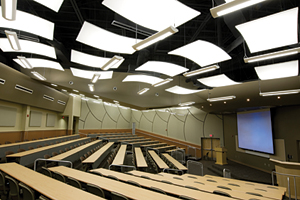Protecting cloud ceilings with fire sprinklers
Report due next month will recommend new installation criteria.

|
|
A cloud ceiling in a lecture hall in a community college. Photo credit: ©istockphoto.com/Jesse Kunerth |
Cloud ceilings are being installed increasingly in commercial and industrial buildings. They frequently function to hide mechanical equipment, improve acoustics or both.
Any ceiling system installed in the same plane with horizontal openings to the structure above on all sides is considered a cloud ceiling. Cloud ceilings consist of panels separated by gaps that sit beneath the structural ceiling of a room or space. Panels range in size from discrete ceiling panels with large spaces in between to close-to-full-room-area contiguous coverage with small gaps at the perimeter wall location.
Cloud ceilings provide challenges to sprinkler protection and National Fire Protection Association 13, “Standard for the Installation of Sprinkler Systems,” does not provide specific guidance. The challenges posed by cloud ceilings include allowing heat from the fire plume to pass through the gaps between panels and walls and develop a gas layer at the ceiling. If sprinklers are only installed at the cloud ceiling level, activation will be delayed. On the other hand, sprinklers installed on the structural ceiling may have their spray distribution blocked by the cloud panels.
Obstruction requirements
In most conditions, NFPA 13 requires sprinklers at both the structural ceiling and cloud ceiling panel elevations. However, there are some situations where sprinklers can be located on one level or the other. Matt Klaus, a senior fire protection engineer at NFPA, clarified the NFPA 13 obstruction requirements that apply to cloud ceilings in his column in the July/August 2012 NFPA Journal.
“NFPA 13 requires sprinklers to be located within 12 in. (30 cm) of the ceiling to ensure that sprinklers will operate once the gas layer develops at the ceiling,” Klaus writes. “The standard also requires sprinklers to be located in such a way that objects within 18 in. (45 cm) vertically of the sprinkler do not prevent the spray pattern from developing and that obstructions more than 18 in. (45 cm) below the sprinkler are not so large that water spray cannot reach large areas of the floor. When followed correctly, these rules will help the designer determine how to handle the cloud ceilings.”
Since the situations where sprinklers can be installed on only one level or the other (i.e. on the cloud ceiling level or structural ceiling level) are limited, code changes to NFPA 13 were proposed to allow sprinkler installation only below the cloud ceiling when the gaps between panels are small, which was defined as being an 8-in. gap or smaller. This measurement was based on modeling done using the Fire Dynamics Simulator, a computational fluid dynamics model developed by the National Institute of Standards and Technology to simulate fire-driven fluid flow. The proposal was rejected, however, due to a lack of validation for the modeling results.
So, in order to gain a better understanding of how cloud ceiling panels affect sprinkler actuation and provide the technical basis for sprinkler installation requirements for cloud ceilings, the Fire Protection Research Foundation initiated a project on the topic. The foundation was formed by NFPA more than 25 years ago to conduct research projects designed to provide information on fire safety problems, with a special focus on those issues related to NFPA codes and standards.
It conducts large and small projects to provide data to the full range of NFPA technical committees dealing with issues such as sprinkler protection, detection and signaling and hazardous materials safety. Foundation projects are conducted by members of the global research community and sponsored by both private industry and government. All foundation reports are available on the website www.nfpa.org/foundation.
Sprinkler installation
The primary focus of the study is to develop guidance on sprinkler installation requirements for large, contiguous cloud panels with the specific objective of determining the maximum gap distance, both between the wall and panel edge and between panels, at which sprinklers located at the structural ceiling are not effective.
The foundation project involves three tasks. The first is to complete a review of literature and modeling data, relevant previous modeling and model validation studies and a corresponding gap analysis. This task includes the work that was completed and submitted as part of the recent NFPA 13 code change proposals.
The second task of the project is the development of a modeling and evaluation plan, which will be based on the gaps identified in the first task, as well as implementation of the plan, which involves fire-testing of various cloud ceiling panel arrangements and fire sizes. These case studies then will be simulated using the Fire Dynamics Simulator to validate the model for this application and to quantify the relative error.
After validation, the FDS will be used to simulate a series of cloud ceiling scenarios to determine the configurations where sprinklers installed in the structural ceiling would not be effective. The modeling scenarios will include a range of gap sizes, fire growth rates, fire locations (i.e. at the wall, between panels, etc.) and ceiling heights.
Recommendations for appropriate sprinkler installation criteria for cloud ceilings will be developed based on the results from the modeling. In addition, recommendations will be made of needed additional studies on the topic. The final report for this project will be complete at the end of June and will be available through the foundation website.
About the author: Amanda Kimball is a research project manager at the Fire Protection Research Foundation, an affiliate of the National Fire Protection Association. She holds a bachelor’s degree in civil engineering and a master’s degree in fire protection engineering from Worcester Polytechnic Institute and is a Professional Engineer in Massachusetts.
HELPFUL LINKS:
Looking for a reprint of this article?
From high-res PDFs to custom plaques, order your copy today!






